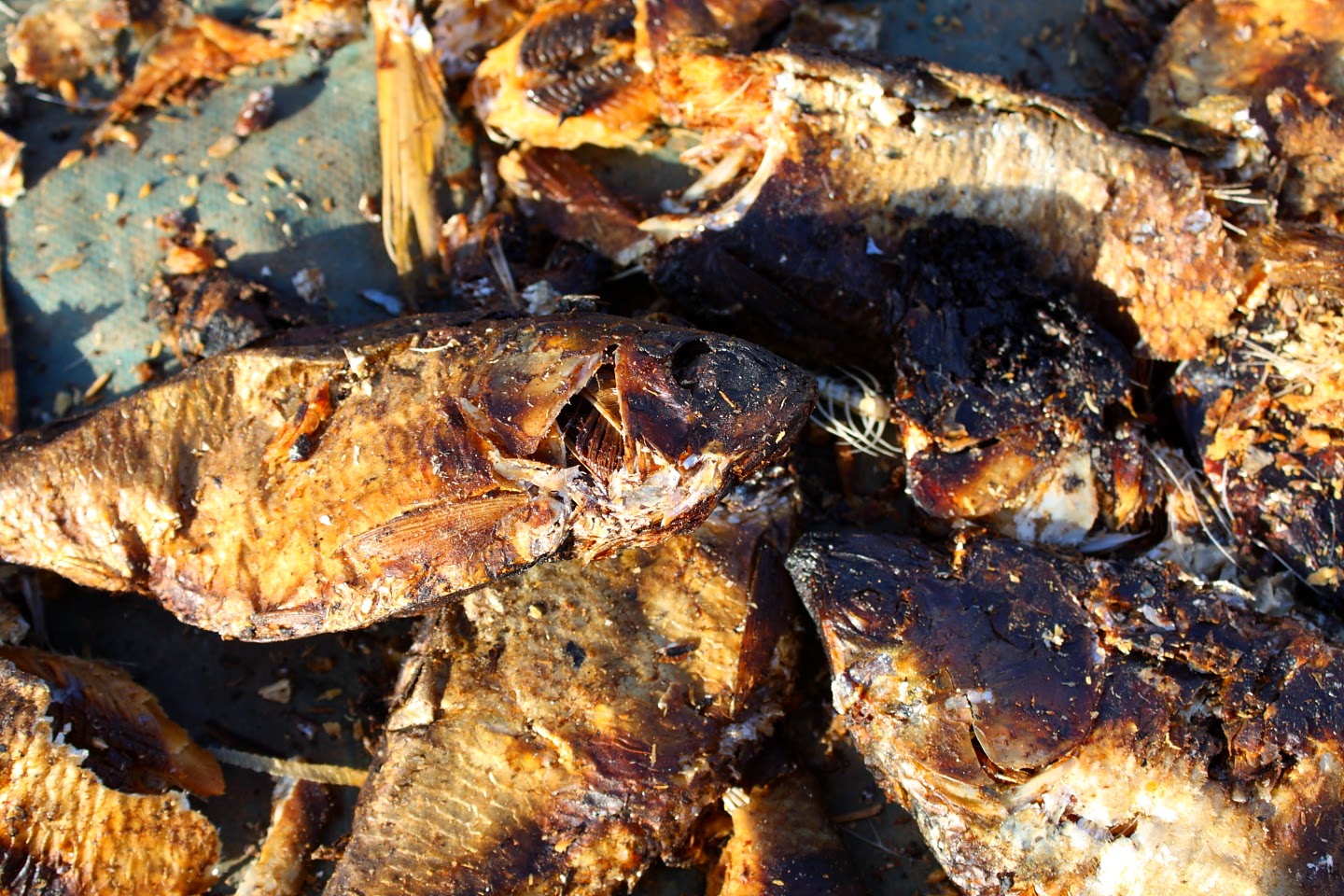咬龍狗,中文大口鰜,英文名 Indian halibut (
Psettodes erumei),分布在印度太平洋,從紅海、東非一直到印尼都有分布的比目魚類,特點是身體極度側扁,以及兩隻眼睛會在身體的一邊。平常在海裡就用沒有眼睛的一邊躺在海底,主要吃食底部的無脊椎生物及魚類。
這大口鰜以前偶爾會在大賣場看到,然而開始對他有興趣,是在一次的出海。那時我們底拖網撈到一隻大魚,當時很開心就把體長體重量好後,就給他放血準備處理。放血半小時後,在處理他時,小指不小心靠近他嘴巴,硬生生給他咬了一口,當下血流如注...從此就對這種魚有印象。更不用說之後因為暈船,比目魚兩吃(切成三片後,骨頭和頭的部分煮薑湯,肉的部分給漁民做咖哩炸魚)只能讓其他同事享用,怨念阿....
日文有句話說
左鮃右鰈,
意思指同一種比目魚種,眼睛是在同一邊,利如鮃類的眼睛在左邊,而鰈類的眼睛在左邊。然而自然就是非常的神秘,往往會出現例外。第一次我處理這種魚的樣本時,發現有一隻的眼睛和圖鑑上的例圖位置相反,那時還很興奮,以為是找到新種。然而和同事討論過後,才知道這是一種型態上的多型性,有些個體的眼睛會在另外一邊。不但在
大口鰜上,在
其他比目魚類也發現過。比目魚類眼睛的位置,一直是生物學家及演化學家討論的
重點之一,而且也是重點期刊(
NATURE)的題目。
在最近的採樣採集到11隻個體,然而也發現到這種眼睛不對稱性的變異: 5隻的眼睛在右邊而其他6隻的個體眼睛在左邊。因此,這就是這篇Blog的主題: 左邊臉和右邊臉,到底在味道上有何差別呢?
Indian habibut (
Psettodes erumei) is a flatfish species distributed from the Red Sea and East Africa to Indonesia waters. It is characterized by highly compressed body form and having both eyes in the same side of the body. The flatfish lay the blind side to the bottom and feed on the bottom invertebrates and other fish.
Indian halibut can be occasionally found in the fish section in the supermarket in Saudi Arabia. I started to be interested in it in one trawl survey. In one trawl, we got a big one, and prepared to have it in dinner after necessary measurements. After bloodletting for half hour, i happened to put my last finger close to its mouth, i got deep bite and my blood went badly. After this accident i have a vivid memory to this species. The fishermen made two dishes out of this big fish, the bone and head is used in the fish bouillon with ginger, and the fillets were seasoned in Sri Lanka style curry and fried. Even though there were delicacies from this fresh big fish, I did not have any piece because of my serious sea-sickness so that i had to spend my whole night in the bed,... SAD....
Generally the eyes locate in the same side for a flatfish species, as the Japanese says "
左鮃右鰈"。For example, the flounders have eyes in the left-hand side (also called "sinistral"), while the soles have eyes in the right-hand side ("dextral"). One amazing part in biology is that exceptions are often found for some widely-known phenomena, and the sides of the eyes for some flatfish species is one of these . As I processing the fish samples from the survey, i found one Indian halibut with eyes opposite to that in the guidebook. I was very excited for I thought of a discovery of new species. However, my Indian colleague told me that this is one of the polymorphism exhibited by
this species. Polymorphism in the eye locations is seemingly common phenomenon that was found for
many flatfish species. For many years, many biologists and evolution scientists are interested in
how the flatfish evolve to have eyes in the same side, and scientists keep having new discovery in recent years and publish them in the highly-respected scientific journal such as
NATURE.
In recent sampling from the fish market, I got 11 Indian halibut speciesmans with 5 right-eyed and 6 left-eyed individuals. Therefore the "objective" of this post is: Do the right-eyed ones have different taste to the left-ones ?
 |
11 Indian halibut individuals.
11隻採集到的大口鰜
|
|
材料與方法
MATERIALS AND METHODS
將魚舖在清茶茶葉上,放上適當薑片後,放在同一個蒸籠裡蒸約15分鐘。蒸好時取出,放上新的薑絲,淋上滾燙的熱香油後,加上酌量的醬油及鹽。
The
fish are seasoned with half-fermented tea leaves and ginger slices, and
steamed in the same steaming pot for around 15 minutes. When the
steaming is done, we put new shredded ginger and pour boiling sesame
oil. Then add some salts and soy source.
 |
One right-ed and left-eyed Indian halibut
左邊臉右邊臉大口鰜各一隻
|
 |
Both are seasoned by ginger slices and tea leaves
同樣用薑片和清茶葉調味
|
 |
Steam for around 15 minutes
在同一個鍋子蒸約15分鐘
|
 |
It is ready by adding shredded ginger, boiling sesame oil, salt and soy source
蒸好後加上新切好的薑絲,淋上熱麻油,加上鹽和醬油調味就可以上桌了
|
 |
Closer view for the right-eyed
右邊臉成品近照
|
 |
Closer view for the left-eyed
左邊臉成品近照
|
結果與討論
RESULTS AND DISCUSSION
和台灣常吃的"扁鱈",可能是太平洋大比目魚(Pacific halibut
Hippoglossus stenolepis)或大西洋大比目魚(Atlantic halibut
Hippoglossus hippoglossus)相比,大口鰜的肉質比較粗、脂肪比較少,所以吃起來沒有扁鱈這麼細緻。然而加上麻油後,這缺少油脂的缺點就不是這麼明顯。和扁鱈相同的是,靠近皮的部分因為有皮下脂肪的關係,比起靠近骨頭的地方細緻。鰭邊肉的部分同時因為有皮下脂肪,以及運動量大的關係,兼具口味及口感,可惜鰭的小刺太多,不方便吃。
左邊臉和右邊臉相比,味道"吃不出有差異"。因為火侯接近、調味一致,大小也相近,所以兩邊的味道吃起來極為接近,如果閉上眼睛,我分不出哪盤是哪盤。因此可以下結論:光以這兩隻來看,在作者的味覺極限下,左邊臉和右邊臉大口鰜,在使用傳統蒸魚的烹調方式上,沒有味道上的差異。如果要做出更強力的結論,則需要增加更多的樣本及試驗才能決定(所以有人要贊助嗎? XD)。
Compared to the "flat cod" that is in fact Pacific halibut (
Hippoglossus stenolepis) or Atlantic halibut (
Hippoglossus hippoglossus), Indian halibut has less fat with stronger muscle fiber and tastes coarser, which is much improved when adding sesame oil. Similar to other halibut species, the part under the skin have finer and smoother taste than the part close to the bones. In addition, the muscles controlling the fins have the best taste and texture for having both the skin fat and high activities. However, the two fish are small so that this part has a lot of small fin base-bones.
I cannot differentiate the tastes from right-eyed to the left-eyed one. Because the two fish are of similar sizes, "treated" with the same way of seasoning, and under the same duration of steaming, the differences in taste should arise from mostly from the differences in body muscular structure, chemical composition.., etc. I fail to detect any difference under my "detection limit" for these two individuals, and more trials should be done for drawing firmer conclusion (Someone wants to help?... haha).



















































